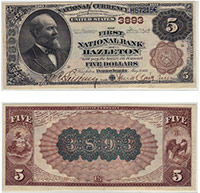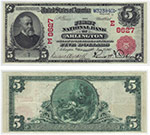National Bank Notes
A national bank note is a type of currency issued by private banks in the United States. The national bank “era” lasted from 1862 until 1935. Over 12,000 different banks issued money. Some of the bank notes are ultra-rare and others are extremely common. The value of any paper money is based on when it was issued and how many are known to exist. The guide below shows all the different types of paper money that national banks issued. We just chose a single denomination per type. Click through to the detailed guides for more pictures and values. You will have to contact us directly if you want to know how many notes like yours are known to exist. All of our information is free. So please send us an email with pictures and we can help. We are unquestionably interested buyers. Info@RareCurrency.com
First Charter National Bank Notes
The first type of bank notes that were issued are called first charter notes. This type of paper money was mostly printed by banks in states above the Mason Dixon line and banks in the Midwest. Most states in the South were still recovering from the Civil War when early national bank notes were being printed. Many cities in the Western U.S. were not developed enough to need a national bank. Anything from this time period issued by a territorial bank is always going to be a special rarity.
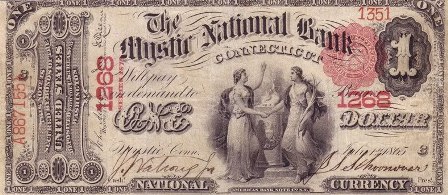 The note pictured above is a one dollar note. National bank notes were also printed for the $2, $5, $10, $20, $50, $100, $500, and $1000 denominations. The $1 and $2 production ended in 1878 and they were never issued again. $500 and $1,000 national bank notes are also unique to the first charter period. They are also extremely rare and virtually non-existent. We have a full guide to first charter paper money. It gives more values, prices, and information about the series.
The note pictured above is a one dollar note. National bank notes were also printed for the $2, $5, $10, $20, $50, $100, $500, and $1000 denominations. The $1 and $2 production ended in 1878 and they were never issued again. $500 and $1,000 national bank notes are also unique to the first charter period. They are also extremely rare and virtually non-existent. We have a full guide to first charter paper money. It gives more values, prices, and information about the series.
Second Charter National Bank Notes
Second charter national bank notes were printed with Series of 1882 on them. The same notes will also have a charter date somewhere between 1882 and 1901 printed on them. The charter date is cursive and it will never affect the value. These were actually printed as late as 1921. There are three different types of second charter notes. The first type is referred to as the brown back series. By the time 1882 rolled around virtually all parts of the country were issuing money. So geography isn’t as important with this money as it was with earlier printings. However, the bank that actually printed the paper money is still extremely important.
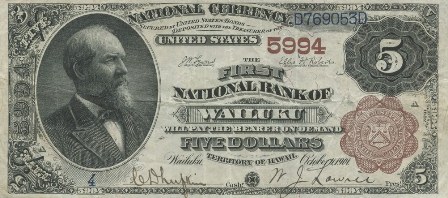
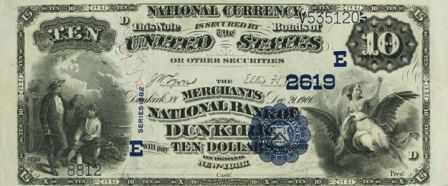 The first picture above is an example of a brown back. As you can see, these bank notes have brown seals. They were printed for the $5, $10, $20, $50, and $100 denomination. The five dollar bill is a particular favorite of collectors. However, fifties and hundreds are almost always the most valuable. We have more pictures and values for 1882 brown backs. The second bank note pictured is known as an 1882 blue seal. They can be broken down further into 1882 date backs and 1882 value backs. $50 and $100 value backs are extremely rare. In most cases though, these blue seals are second class citizens compared to brown back varieties.
The first picture above is an example of a brown back. As you can see, these bank notes have brown seals. They were printed for the $5, $10, $20, $50, and $100 denomination. The five dollar bill is a particular favorite of collectors. However, fifties and hundreds are almost always the most valuable. We have more pictures and values for 1882 brown backs. The second bank note pictured is known as an 1882 blue seal. They can be broken down further into 1882 date backs and 1882 value backs. $50 and $100 value backs are extremely rare. In most cases though, these blue seals are second class citizens compared to brown back varieties.
Third Charter Red Seal Bank Notes
The third charter period is broken up into two different issues. The first types of money were printed between 1902 and 1908. All of these bank notes have a red seal. Collectors generally refer to them as 1902 red seals.
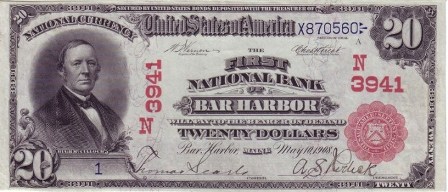 Red seals are very popular. They usually represent a chance to buy a rare and early example of a scarce bank note. All of these bank notes say series of 1902 them. However, these were actually printed as late as March 1908. Millions upon millions were printed, but they are few and far between today. Serial Number One notes (with a #1 below the portrait) are always in demand. True high grade notes, like CU and better, are very rare. You should still consult us for actual values. Prices range widely and you need to work with an expert to establish that value. We have more information about 1902 red seal bank notes.
Red seals are very popular. They usually represent a chance to buy a rare and early example of a scarce bank note. All of these bank notes say series of 1902 them. However, these were actually printed as late as March 1908. Millions upon millions were printed, but they are few and far between today. Serial Number One notes (with a #1 below the portrait) are always in demand. True high grade notes, like CU and better, are very rare. You should still consult us for actual values. Prices range widely and you need to work with an expert to establish that value. We have more information about 1902 red seal bank notes.
Third Charter Blue Seal Bank Notes
Blue seals are the most common large size national bank notes. All examples say series of 1902. The actual years of production are 1908 to 1928. In the scheme of things that is not especially long ago. These are still discovered on a regular basis. Some rarer notes can be worth thousands of dollars. Common examples sell for between $40 and $500.
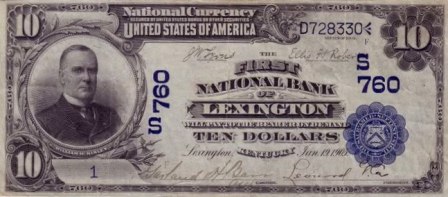 Five different denominations were printed (five, ten, twenty, fifty, and one hundreds). Everything about the design was the same as the earlier red seals, except that the seal and charter numbers changed to blue. Blue seals can further be broken down into 1902 date backs and 1902 plain backs. Neither type commands a premium over the other. See our full guide about 1902 blue seals.
Five different denominations were printed (five, ten, twenty, fifty, and one hundreds). Everything about the design was the same as the earlier red seals, except that the seal and charter numbers changed to blue. Blue seals can further be broken down into 1902 date backs and 1902 plain backs. Neither type commands a premium over the other. See our full guide about 1902 blue seals.
1929 Small Size National Bank Notes
The last kind of national bank notes that were issued are called series of 1929 small size notes. This type of money is the same size as currency is today. The people featured on each bill is the same as today as well.
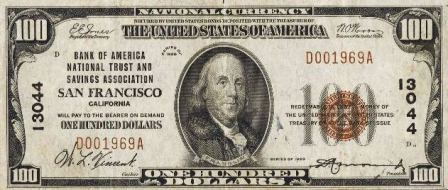
Only very rare types of this money can be worth more than $500. 98% of the money we see typically sells in the $40 to $400 range. There are always exception to that rule. So don’t assume your note is common without asking us first. You can also visit out 1929 national bank note guide for more pictures and values.
